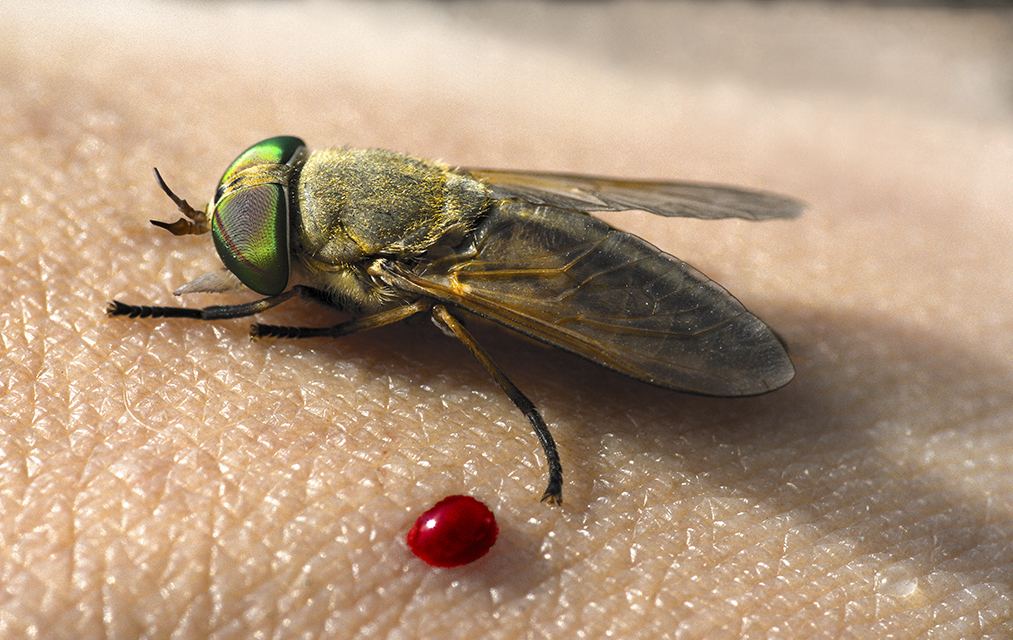
LSU scientists find greenhead horseflies can help measure marsh health
Anyone who has ever been attacked by a greenhead horsefly would rejoice at the prospect of the species’ demise. However, LSU researchers have found there is a benefit to having the green menace in the Bayou State: The prevalence of the vicious little vampires is important indicator of the health of coastal marshes.
Almost immediately after the Deepwater Horizon began spewing oil into the Gulf of Mexico in 2010, LSUAgCenter entomologists Lane Foil and Claudia Husseneder headed for the Louisiana coast to gather data on coastal insects.
They soon designed a study that combined Foil’s interest in horseflies as a disease vector in horses and cattle with Husseneder’s passion for insect population genetics. The aim was to determine whether the size of greenhead horsefly populations correlated with the health and recovery of the oil-damaged marshes.
|
|
The project was first funded by the National Science Foundation and then by a Gulf of Mexico Research Initiative (GoMRI) bridge grant.
A bane to both people and animals and famous for its fierce bite, the greenhead horsefly is one of few insects that is native to and tightly bound to specific coastal marsh habitats in Louisiana.
As the top predator of other invertebrates, Foil says, “Their abundance is reflective of the health of the invertebrate food web around them in the mud of the tidal marshes.”
 The researchers selected six locations along the Louisiana coast and began gathering population data on adult greenhead horseflies.
The researchers selected six locations along the Louisiana coast and began gathering population data on adult greenhead horseflies.
Grand Bayou, Grand Isle and Elmer’s Island in southeast Louisiana were tainted from the oil spill. Meanwhile, the Ship Channel, Rockefeller Wildlife Refuge and Cypremort Point in southwestern Louisiana were pristine. So, the situation gave researchers the opportunity to compare how oil intrusion affected the marsh.
Horseflies captured at the pristine sites ranged from nearly 37 to more than 92 flies per hour. Traps in the oiled areas collected fewer than five flies per hour.
Researchers suspect lack of fresh water and the flies’ fatal attraction to oil sheen were likely responsible for the significant decline in affected areas. Results from the initial research appeared in a Nature journal.
Foil and Husseneder also predicted the genetic diversity and effective population size will probably decrease for several generations until other horse flies move into the areas to replenish the gene pool.
To investigate that possibility, the GoMRI Research Board recently awarded the scientists nearly $2 million to extend their study to horsefly larvae and the invertebrate food web.
“We know oil had an impact on the species,” Foil explains. “[Now], we want to find out if the affected environments are recovering.”
Not surprisingly, samples of marsh soil showed far fewer larvae in the oiled areas than in the pristine sites. “This sustained population suppression was likely due to toxic effects directly to the larvae or their food web,” Husseneder says.
The researchers are continuing with genetic studies and larval surveys to identify bioindicators to determine whether increases in populations are the result of new flies moving into the area or if the marsh sediment has detoxified sufficiently to allow the local populations to recover.
“Insects and the food chain will tell us a lot about the biology—how populations improve and how populations are replenished,” Husseneder says.
She also says the results from these and future studies will be an important element in evaluating mitigation and coastal restoration efforts.
So, Louisiana residents may want to keep a swat team close by. With the marsh populations on the rebound, these bloodsucking barometers are probably in the Bayou State to stay.
Creature feature
If you’d rather spend time with cuddly canines instead pondering the prevalence of annoying insects, YelpBR! has many adorable options including:
 Mimsy is an 8-month-old Chiweenie. This sweet cuddly lap dog is a little shy; but, she is slowly coming out of her shell in a foster home.
Mimsy is an 8-month-old Chiweenie. This sweet cuddly lap dog is a little shy; but, she is slowly coming out of her shell in a foster home.
Benny is an 11-year-old male Lhasa Apso. He was surrendered by an owner. Despite his advanced age, he’s in excellent health and ready for a new home.
 Maggie is a 7-year-old old poodle mix. This mature, calm, sweet cuddlebug gets along with other dogs and is house- and crate-trained. She is best suited for a home without small children.
Maggie is a 7-year-old old poodle mix. This mature, calm, sweet cuddlebug gets along with other dogs and is house- and crate-trained. She is best suited for a home without small children.
Reecey is a 7-year-old longhaired dachshund. Her owner recently surrendered her to Yelp, so the rescue is still learning about her personality.
Shiloh is a 5-year-old, male Corgi mix. He is basically a sweet little guy, who likes to act tough at times.
Angel was left tied to Yelp’s porch one night in the rain. Luckily, a volunteer saw her and immediately brought her inside. Angel was given her name to reflect her loving temperament. This beautiful Rhodesian ridgeback loves to run and play, so she is best suited to a family who has a fenced in yard and the time to engage her in outside activities.
Many other puppies and dogs are available at Yelp!BR.
|
|
|




